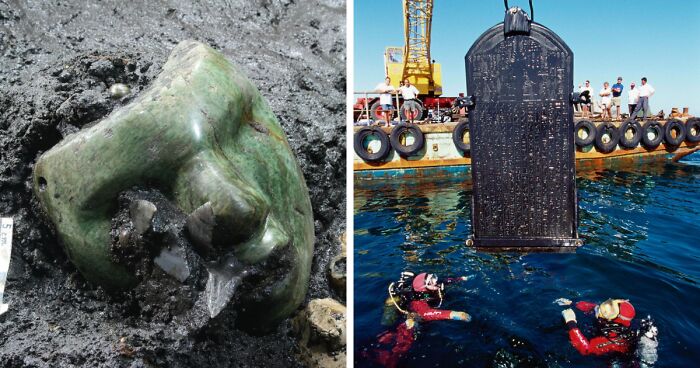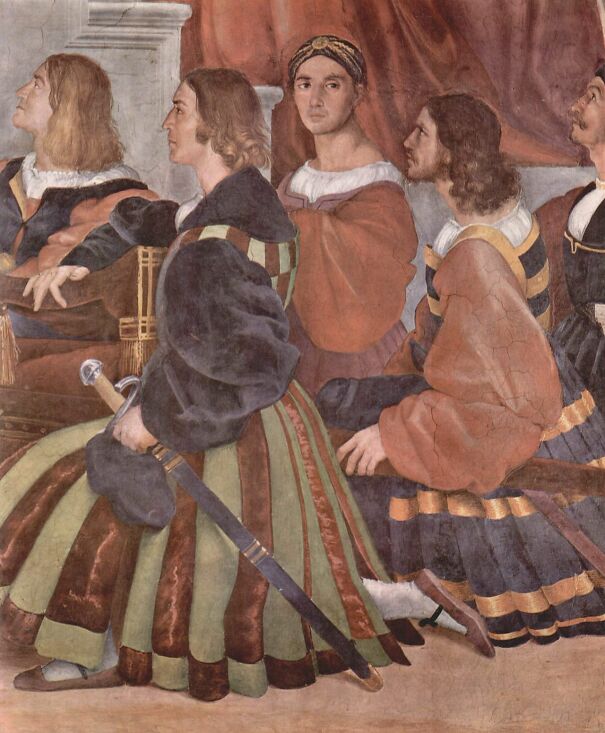
50 Amazing Artifacts That Still Surprise People To This Day, As Shared On This Online Group
Interview With AuthorDespite what it can sometimes feel like in a dull classroom, history is a lot more than just “random” dates and dead people. It shaped and continues to shape the world around us. Through the things our ancestors left behind, it can be a lot easier to see just how similar they were to us.
The “Museum of Artifacts” page shares interesting and cool items from history. We got in touch with the page’s creation and administrator to learn more. So get comfortable as you scroll through, upvote your favorites and be sure to comment your thoughts below.
More info: Facebook | Instagram | TheTravelBible
This post may include affiliate links.
It Is Not A Real Rope Net, But That It's Meticulously Carved In Marble. "Disinganno", Francesco Queirolo, 1753-1754, Sansevero Chapel (Naples, Italy)
A Fabric Womb Made By Angélique Du Coudray, A French Midwife Who Was Commissioned By King Louis Xv To Reduce Infant Mortality
From 1760 to 1783, she traveled all over France, visiting poor rural women and sharing her extensive knowledge with them. It is estimated that she trained some 10,000 women.
Du Coudray also invented the first lifesize obstetrical mannequin, for practicing mock births, and published a well-received midwifery textbook
That's amazing! Most women at that time did not receive education about how their bodies birthed a baby, so this probably saved many lives by giving towns properly-trained midwives.
In Ancient Rome, Roads Were Dotted With White Stones (Cats' Eyes) Which Reflected The Moonlight, Acting As Street Lights To Help People Walk On The Street After Dark. Pictured Is A Roman Road In Pompeii
Bored Panda got in touch with the admin and creator of “Museum of Artifacts” and they were kind enough to answer some of our questions. Naturally, we wanted to hear the history behind the page itself.
“So a museum of artifacts was created 9 years ago, first on Facebook and Tumblr. As a history freak I found there is no place where you can find artifacts. So I started to post and then, quickly the community grew so much. There are hundreds of thousands of people who love history but not only in the books.”
This 14th Century Door At Exeter Cathedral, UK, Is Thought To Be The Oldest Existing Cat Flap
Is that cat flap intentional or did 700 years worth of cats just claw their way through that door?
Fall Of The Rebel Angels, Carved Out Of A Single Piece Of Marble In 1740 By Italian Sculptor Agostino Fasolato, It Depicts 60 Fallen Angels
An Egyptian Rock Crystal Of A Chonky Hinpopotamus Amulet, Middle Kingdom, Ca. 2050-1650 Bce
The page has gotten quite large and now also includes a separate blog, the aforementioned Facebook page and an Instagram account. So we wanted to hear the admins' thoughts on what actually made it so wildly popular. “When you see a small amber bear that was made 5k years ago, when you see carbonized bread from Pompeii or a dinosaur skeleton that was folded in a super funny way you can imagine that those people were just like us.”
Detail From The “Unswept Floor” Mosaic Made By Heraclitus, Showing A Mouse Eating A Walnut. 2nd Century Ce, Now On Display At The Vatican Museums
I've seen the mouse before, but I've never seen the whole thing! The details are incredible.
14000 Years Old Bisons Sculptures Found In Le Tuc D'audoubert Cave. Ariege, France
These are so well carved. Especially considering that in a cave, there wouldn't have been any natural light.
The 2000-Year-Old Clothes Of The Huldremose Woman, A Bog Body Recovered In 1879 From A Peat Bog Near Ramten In Denmark
It consists of a checked woollen skirt, a checked woollen scarf and two skin capes. Now on display at the National Museum of Denmark
The skirt is incredibly well preserved. It looks slightly worn, but not very old
“They love to see and share objects, sometimes truly amazing, that were part of someone’s lives thousands of years ago,” they shared. We wanted to know how finding things to post worked from the admin side. “Museum of Artifacts is run by one person alone, non profit, never posted a single ad or referral.” Pages like this have the added benefit of making parts of history more accessible to the general public.
Gilded Silver And Rock Crystal Vessel, Crafted In Nuremberg, Germany, Circa 1580
An Adorable Ancient Egyptian Otter Statue!
Dating to c. 640 - 30 BCE, it depicts a bronze otter on its hindlegs, forepaws raised in praise of the sun. The solar disc of Ra rests upon its head.
Abuna Yem’ata Guh In Ethiopia. Situated At A Height Of 8,460 Ft, The Hewn Church Has To Be Climbed On Foot To Reach. It Is Notable For Its Architecture, Dome & Wall Paintings Dating Back To The 5th Century
they didn't even do this at the top? I'm guessing someone was climbing this sucker and got to this point and said, "f**k it. Let's just do it here".
Given the sheer amount of content the page shares, we also wondered if they had any favorites. “Toys or doodles made by kids a long time ago amazes us. And there are still more questions like Gobekli Tepe, in which we still don’t know much about our past, which was complex and advanced.”
A Megalithic Monument In Spain That's Older Than The Pyramids Was Recently Uncovered From Its Watery Hiding Place By A Drought
The "Spanish Stonehenge" is about 7,000 years old, some 2,000 years older than Stonehenge itself.
A Roman Bronze Colander From Pompeii, Italy, 1st Century Bce
Just checked Google, and it looks like no one is yet selling a replica of this. Good opportunity for someone who likes metalworking. I know I'd buy one!
In 1965, Excavations In Mezhyrich, Ukraine, Revealed The Presence Of 4 Huts, Made Up Of A Total Of 149 Mammoth Bones
These dwellings, which are about 15,000 years old, are some of the oldest shelters known to have been constructed by pre-historic man.
The admin shared a person's favorite, old bison sculptures found in Le Tuc d'Audoubert cave, in Ariege, France. “14k years ago and such artistic talent,” they shared with Bored Panda. So be sure to give them a follow. You can find more on their Facebook page, Instagram and other sites.
Roman Army Knife (201-300 Ad); Has A Spoon, Knife, Fork, Spike, Spatula And Pick Allowing The User To Even Clean Between Their Teeth After Eating. It Was Part Of The Equipment Of Roman Legions
This folding eating gadget has a three-pronged fork, a spoon,a spatula,a pick, a spike and an iron knife that has eroded away. There is a hinge to allow each item to be folded out when it was needed, or folded away for ease of transporting it.
The spike might of helped in extracting the meat from snails, and the spatula in scraping sauce out of narrow-necked bottles. Some have even suggested the pick with the tiny spoon on the end could have been used to remove earwax.
I wonder how, in the future, this became a "Swiss" army knife?
A 2,000-Year-Old Green Serpentine Stone Mask Was Found At The Base Of The Pyramid Of The Sun In Teotihuacan, Mexico
It's believed that these offerings were left as part of a ritual to inaugurate the construction of the pyramid, hence its location at the lower level. The mask itself is extremely lifelike, which gave rise to the theory that it's actually a portrait. This would be incredible, as archaeologists have little information about the people who constructed Teotihuacan. There are also conflicting theories about the exact use of the pyramid. Even the name isn't original.
A 1800-Year Old Ceramic Horse. Han Dynasty (202 Bce– 9 Ce, 25–220 Ce), Now Housed At The Sanxingdui Museum In China
Frog, By The Japanese Artist Matsumoto Hoji. 1814 Ce
Pictured Above Is The Marble Lace Neckerchief Carved By French Sculptor Louis-Philippe Mouchy (1734 - 1801), Who Masterfully Created The Marble Statue In 1781
The statue was commissioned as a posthumous tribute to the Duke of Montausier, Charles de Sainte-Maure. The nobleman was one of the guardians of the Great Dauphin of France, Louis, son and heir of the Sun King, Louis XIV.
Ax From Viking Era, Before And After Conservation 10th–11th Century
Roman Brick From Cherchell, Algeria With A Perfect 2000 Year-Old Imprint Of A Human Hand
The handprint is seemingly that of a large Roman man, who pressed his hand into the brick as it lay out to dry before firing. Closer inspection reveals the fingerprints and skin textures of the man.
For The First Time In 12,000 Years, The Teeth Of A Leopard Statue Saw Daylight In 2021 At Karahantepe, Türkiye
A Black Mug. Southern Italy, 2400(!) Years Old
Château De Chenonceau, Indre-Et-Loire, France
Arguably one of the most impressive inhabited bridges still in existence, the present-day structure, dating back to the 16th century, was constructed upon an arched bridge spanning the Cher River. This unique design allowed the owner to access the hunting grounds located on the opposite side of the river.
It is called the Ladies' Castle, because it was owned (almost) entirely by noble ladies.
An Ancient Glass Bowl With Blue And White Canes. Greek Or Roman, 100–1 Bce, Now Housed At The J. Paul Getty Museum In Los Angeles
Great Zimbabwe Was A Medieval African City Known For Its Large Circular Wall And Tower. It Was Part Of A Wealthy African Trading Empire That Controlled Much Of The East African Coast From 11th-15th Centuries Ce. Great Zimbabwe Is The Name Of The Stone Ruins Of An Ancient City Near Modern Day Masvingo, Zimbabwe. People Lived In Great Zimbabwe Beginning Around 1100 Ce, But Abandoned It In 15th Century Ce. The City Was The Capital Of The Kingdom Of Zimbabwe, Which Was A Shona (Bantu) Trading Empire. Zimbabwe Means “Stone Houses” In Shona
Something that tricks a lot of people into thinking these ruins are very old is is that they look similar -for shape, materials and preservation status- to the bronze age settlements found throughout Europe. In fact, this was created much, much later. About 3000 years later, in the 15th century. As a comparison, the Great Mosque of Cordoba had been completed over four centuries before, many noble palaces in Florence were already in use since 2-3 centuries and the Tower of London had already seen four major rebuildings and had been the scene of a few prominent royal murders.
Gold Ring, Roman Egypt, 1st Century Ad
Johann Sebastian Bach's Handwritten Personal Copy Of His Mass In B Minor, Held By The Berlin State Library, And Added To Unesco's Memory Of The World Register
The Mass in B minor (completed in 1749) is widely regarded as one of the supreme achievements of classical music.
Bison Sculpted From Mammoth Ivory. Found At Zaraysk, Russia. About 20,000 Years Old
It’s so cool that someone’s art from TWENTY THOUSAND YEARS AGO is still identifiable.
A Steam-Powered Elevator In The House Of Guard Captain S. Muyaki In St. Petersburg, Russia. Circa 1902-1903
Ancient Greece Toys. About 2300 Years Old
Kids of Ancient Greek times had a number of Ancient Greek toys to play with, in their leisure and free time. Some of them included- dolls, rattles, tops, swings, etc. Along with these, many other items of play have been unearthed by archaeologists. These were a key part of Ancient Greek childhood.
"Memento Mori", German Mammoth Ivory Skeleton - Second Half Of The 18th Century
In 1663, The Partial Fossilised Skeleton Of A Woolly Rhinoceros Was Discovered In Germany. This Is The “Magdeburg Unicorn”, One Of The Worst Fossil Reconstructions In Human History
I'd love to meet the paleontologist who looked at that and went, yeah, should be right
Michelangelo's Secret Drawing Room Was Found Under A Church In Florence, Italy, In 1975 And Is Now Open To The Public
The discovery of the secret room in the 19th century sparked renewed interest in Michelangelo’s lesser-known works. Today, the room is considered a hidden gem of Renaissance art, offering a glimpse into the private world of one of history’s greatest artists and the influential patrons who supported him.
3,700-Year-Old Ancient Clay Tablet Containing Applied Geometry. A Millennia Before The Birth Of Pythagoras
Ship's Biscuit With Inscription. Great Yarmouth, England, 1885
Rhyton In The Shape Of A Dog's Head, Greece, Circa 480 Bc
Ivory And Ebony Chess Pieces Shaped Like Insects. Italy, 1790
Oh, my grandfather would have loved this :) He died last year, he was an entomologist and one of his favorite pastimes was playing chess.
Wedding Mantua Worn By Helena Slicher, Over 2 Meters Wide. The Netherlands, 1759
The Only Bucket Made Of Wood That Has Survived From Roman Times
The characteristic spout allowed the liquid to be poured out easily. The object was aboard a river ship sunk 1,800 years ago on the Rhine.
Carved Ivory Japanese Netsuke Depicting A Human Skeleton Posing On A Large Human Skull, C. 1750-1850
Holy Trinity Church, A Historical Building In Hrastovlje, A Village In Southwestern Slovenia, It Is A Romanesque Church From 12th Century Ce. Church Stands Behind A Wall That Local Population Built To Protect Itself From Turkish Attacks In 16th Century Ce
Such defensive architectures are found throughout territory settled by Slovenians and are called tabor. Church in Hrastovlje differs from all other pilgrim churches in that its bell-tower is located on western side and in that all other pilgrim churches have small wooden towers.
Welcome to the Holy Trinity Church. We welcome all God's children. Except the f*****g Turks.
Rock Engravings Of Val Camonica In Brescia, Italy
It is one of world's largest and most mysterious collections of prehistoric petroglyphs, crafted by enigmatic Camuni civilization over 10,000 years and recognized as Italy's first UNESCO World Heritage Site.
Ancient Near Eastern Clay Vessel With Two Feet (1000–800 Bc), From Northern Iran
A tall vessel with an oval, almost bag-like body, a somewhat elongated neck with an everted rim and a pair of narrow curving handles that spring from the oblique shoulder to the neck. The lower portion of the vessel splits into two legs with well-modeled feet. Details such as ankle bones and the arch of each foot are rendered by modeled forms rather than incised lines. The overall effect is that of a wine- or waterskin rather than a ceramic vessel. It is likely that this association was intentional- as the light porous ceramic body of the vessel allows water to evaporate slowly through the sides, thus slightly cooling the remaining contents.
"Well you must have left it somewhere, it can't have grown legs and walked off" "uh...you might wanna see this..."
A Little Alpine Refuge That Was Built More Than 2700m Above Sea Level In Italy’s Dolomite Mountains (Mount Cristallo) Is Among Most Dramatic Reminders Of Wwi
This incredible refuge has been built inside one of the peaks of the massif, with brick walls, a slanted roof, two doorways and four windows framed in wood. Some of the windows are shuttered.
Thonis-Heracleion Was One Of Egypt's Greatest Ports, But It Slowly Submerged Into The Sea From C.100 Bce-800 Ce
Here, we see a stele from the reign of the Pharaoh Nectanebo I (r.380-360 BCE) being excavated in 2000 CE, the same year as city's rediscovery.
For those like me who are curious, a stele is a stone or wooden slab, generally taller than it is wide, erected in the ancient world as a monument. The surface of the stele often has text, ornamentation, or both. These may be inscribed, carved in relief, or painted (Wikipedia) The plural is apparently stelae
Viking's Blacksmith Tools And Weapons Found In Grave, Ca. 800 A.d. Norway
A Horreo Is A Traditional Granary Or Storage Building Commonly Found In The Northwest Region Of Spain, Particularly In Galicia, Asturias, And Cantabria
These structures are typically raised off the ground on pillars or stilts to protect the stored grain or food from moisture and pests. Horreos are characterized by their unique architectural design, featuring a rectangular or elongated shape with slatted walls or vents to allow for air circulation.
The construction of horreos dates back centuries, with some examples dating as far back as the Middle Ages. They were originally used to store and preserve crops such as corn, wheat, and other grains, as well as other food items like potatoes and beans. The elevated design of horreos helps to keep the stored goods dry and safe from rodents and insects.
Horreos are not only functional structures but also hold cultural significance in the regions where they are prevalent. They are often decorated with intricate carvings, symbols, or patterns, reflecting local craftsmanship and traditions. In addition to their practical use for food storage, horreos have become iconic symbols of rural life in Spain, attracting tourists and visitors who appreciate their historical and architectural value.
Details Of The Dolphin's Armor Of Henry, The Future King Henry II Of France, Made By Negroli Francesco In Milan In The 1540s. Now On Display At The Army Museum In Paris
A Lamassu, Or “Protective Deity”, From The Palace Of Assyrian King Sargon II (R. 722-705 Bc)
This 16ft high and weighs 40 tons sculpture was excavated during archaeological exploration between 1928-1932, at Dur-Sharrukin (present day Khorsabad, in northern Iraq). At the time, Dur-Sharrukin was the capitol of what is now known as the Neo-Assyrian Empire. The city was abandoned after Sargon II died in battle in 705 BC, against the province of Tabal in Anatolia (Türkiye), and the capitol was then moved to Nineveh.
Polish Hussar Armor For Ottoman Grand Vizier Sinan Pasha, Xvii Century
wonderful craftmanship. No power tools, no modern material sheets or hardware. Simply stunning.
Found In 1867, The Orkney Hood Is The Only Complete Piece Of Clothing To Survive From Before The Medieval Period In Scotland
The garment was lost or deliberately left in a bog over 1,500 years ago and the lack of oxygen slowed its decay for centuries.
These bog textiles are incredibly well preserved. We're so lucky to have them.
The Lion's Gate Of Mycenae In 1250 Bc Is One Of The Oldest Giant Structures In Europe And One Of The Largest Statues Created In Aegean History
Octopus Vase From Palaikastro. Greek, 1500 Bce
The Sacred City Of Caral In Peru. At Almost 5000 Years Old, It's The Oldest City In The Americas And Predates Even The Great Pyramids Of Egypt. It Includes 6 Pyramids, The Largest Of Which Measures 150x160 Meters, 2 Sunken Ceremonial Plazas, Residential Districts And An Irrigation System
In 2014, Norwegian Archaeologists Found A Lone Wooden Ski On A Mountaintop, Where It Had Been Trapped In Ice For 1300 Years
Because skis come in pairs, archaeologists monitored the ice patch for summertime thaws that might reveal the other one. 7 years later, their patience has paid off
Lots of artifacts are being exposed as Scandinavian glaciers melt due to global warming and every year archeologists comb their facing edges looking for them before they're lost.
Life-Size Statues Of Sumo Wrestlers, Made By Yasumuto Kamehachi In 1890
One Of Two Huge Marble Lustration (Ritual Purification) Urns That Were Brought To The Hagia Sophia From Pergamon During The Reign Of The Ottoman Sultan Murad III
They are from the Hellenistic period and were carved from single blocks of marble in the 2nd century BCE. Istanbul, Turkey
The Giant Flag Of The French Ship Le Genereux, Which Was Captured By One Of Admiral Nelson's Captains Sir Edward Berry At The Battle Of Malta Convoy In 1800. (With Humans For Scale)
Funeral Portrait Of An Egyptian Woman Named Aline, Found In An Ancient Egyptian Grave In Hawara From The Time Of Tiberius Or Hadrian, C. 42 Bc - Ad 138. She Would Be Found With 7 Others, Including Her 2 Daughters And Husband
Gaetano Cellini's Marble Masterpiece: 'Humanity Against Evil' At The National Gallery Of Modern Art, Rome
Anthropomorphic Figure Of A Polar Bear With Its Cub. Medium: Carved Walrus Ivory. Culture: Native Alaskan. Date: C. 1800 To 1900. Place Of Origin: Bering Sea
Medieval City Walls (12th-13th Centuries Ce) Of Provins, Seine-Et-Marne, France. The Historic Walled City Of Provins Is An Outstanding And Authentic Example Of A Medieval Fair Town In Champagne, A Region That Was An Important Centre Of Exchange, And Which Witnessed, Together With The Rise Of Trading Fairs In 11th Century Ce, The Beginning Of Significant International Trade In Europe
I lived in Provins when I was very young. The walls then were slowly crumbling. In the 70s à great effort of préservation started and now à good part of the ramparts have been restored. They, and the "Ville Haute" (high town) they enclose are the venue in spring and summer for many historical events and shows. Provins is a nice town with a lot of historical stuff to visit, lovely parks, and à beautiful rose garden.
Corinthian Helmet From The Battle Of Marathon (490 Bc) Found With The Warrior's Skull Inside
"Devil In The Glass". Cast In Glass, The Small Figure Of A Devil Is Made Of Black Lead
According to a description in the Viennese Treasury from 1720, this is a “spiritus familiaris”, a spirit that was exorcised from a possessed person and banished to the glass. 1600-1650 CE, Austria
The proof that even the devil appears as a leader sometimes...🤹🏽 🤘🏽 🧖🏽
Two Stuffed Frogs Having A Sword Fight, Found In A Late 19th Century French Mansion "Maison Mantin" After It Had Been Sealed For More Than 100 Years, From 1905 To 2010
This kind of sculptures were a coveted prize for some noblemen's "Cabinets de Curiositè" (or wunderkammer, in the German area) . It was trendy to collect curious, rare or interesting pieces as conversation starters and as proof of the intellectual curiosity of the owner, his travels and his good taste. For some, the appeal was more into the esoteric (collecting specimens of "mermaids" and monsters made with taxidermy), other preferred very niche collections of a single type of item that were pursued relentlessly, while some others -such as this gentlemen- appreciated more searching for the occasional funny and grotesque artwork.
Medieval Ax With A Preserved Wooden Handle Discovered On The Island Of Ledniczka In Poland
Aquamanile Depicting Airstotle's Girlfriend,phyllis,riding Him Around The Garden After Aristotle Warned Alexander The Great About Women.copper Alloy,south Lowlands,14th-15th Century Ce(Metropolitan Museum Of Art In New York City)
British Archaeologist Leonard Woolley And His Wife Catherine At The Moment Of The Discovery Of Pottery Pipes That Were Used As A Sewage And Rainwater Network In What Is Considered The First Water Drainage System In History Before About 4000 Bc. Ur (Mesopotamia) In 1930. More: Https://Thetravelbible.com/Museum-Of-Artifacts/
The Uniform Worn By King Charles Xii Of Sweden When He Was Killed By A Stray Shot During The Siege Of Fredriksten On 30th November 1718, Now In The Collections Of The Royal Armoury In Stockholm, Sweden
Ancient Greek Spartan Shield, King Leonidas Shield With Greek Letter L
Ancient Greece Legend of 300 Spartans, Greek Art Metal Sculpture "Come and get them" ( "ΜΟΛΩΝ ΛΑΒΕ") inscription onto the backside grip Big Greek initial letter L for Λακεδαιμονιοι/Lacedaemon
The shield is in solid copper sheet with verdigris patina and stands on a bronze tripod and measures 33.5 cm in diameter (540-480 BC)…
Woollen Cap Found In The Grave Of A 17th Century Dutch Whaler
"In 1980 archaeologists investigated the graves of 185 Dutchmen – whale hunters, and workers at whale oil refineries – who had died on or near Spitsbergen in the 17th century. Many skeletons were still wearing their knitted woollen head coverings. These caps were highly personal. The men were bundled up against the severe cold and could only be recognized by the colours and patterns of their caps. Presumably this is the reason why the caps went with them into their graves."
Ancient Egypt Socks Designed For Sandals. 2400 Years Old
Pazyryk Carpet 550 Bc The Oldest Known Surviving Carpet In The World. More In Comment
Abandoned Hotel Belvédère Was An Iconic Swiss Hotel On The Edge Of The Rhone Glacier. It Was Built In 1882 By Young Hotelier Josef Seiler In One Of The Hairpin Bends Of The Furka Pass, One Of The Snowiest Regions In Switzerland
The panoramic location attracted a pampered clientele who sometimes stayed for weeks during the summers
The Remains Of A Prehistoric House From The Bronze Age Settlement Of Akrotiri In Santorini, Greece. The Settlement Was Destroyed In The Theran Eruption Sometime In The 16th Century Bce And Buried In Volcanic Ash
I personally think this was the basis for Atlantian mythology. Seeing that they were, as I recall, Minonian settlements, they were a bit of a contrast to the Mycenaean Greeks on the mainland.
A Pair Of Levi's Jeans From The 1880s Found Down An Abandoned New Mexico Mine Have Been Sold At Auction For A Total Of $87,400
They are flecked with wax over the legs from where the original owner labored under candle light.
A Boy's Dress With Mother-Of-Pearl Buttons. England, Around 1865
The 6m Tall Lion Of Chaeronea In Greece, Erected In 338 Bc
Under the monument, archaeologists unearthed a mass grave of 254 people, generally accepted to be the remains of the military unit known as "The Sacred Band of Thebes" who were wiped out completely by Philip II of Macedon.
"You know what a lion looks like, right?" Sculptor: "Yeah, of course!"
The Imperial Crown Of The Holy Roman Empire (Worn By Soldier Circa 1945). Made In 962 A.c
Death Mounted On A Lion' (1513 Ce), Middle Franconia
A Pair Of 15th Century Venetian Calcagnetti, The Soles Add 43cm (17 Inches) To The Wearer's Height
Women who wore them needed support from their maids while walking. Despite a safety ban in 1430, the custom continued until the 1650s
It allowed rich women to (precariously) walk the less-than-clean streets of the time without mucking up their dresses.
The "Ghost Wagon" On Detroit Lake In Oregon Appeared In 2015 When Water Levels Dropped To Historic Lows. The Wagon Was Built By The Milburn Wagon Company Of Toledo, Ohio Around 1900 And Was Probably Used To Transport Freight
Unfortunately it's extremely fragile to remove and display properly preserved, so it was left in place. It is vulnerable to chance boat anchors and the whims of careless tourists looking for a souvenir. It is thankfully protected by it's non published location and water depth, but I hope funding could be had for it's conservation.
The Only Surviving Exemplary Of A Giornea From The Xv Century
Journade (France) or Giornea (Italy) is a sideless overgown or tabard.[1] It was usually pleated and was worn hanging loose or belted. Young men wore them short and older men wore them calf- or ankle-length. They are still worn by the Vatican's Swiss Guards. 1280px-Raf...4ecb23.jpg 
Viva La Vulva Amulet: Crowned, Mounted On A Horse, Wielding A Crossbow And A Torch, In Silver. Medieval European Pilgrims Wore These Apotropaic Medals To Protect Against Plague, Robbers, Rapists, And Other Dangers
Wrong description again. These symbols were satyrical decorations used in Northern Europe during carnival. They *mocked* the pilgrims' badges, that often featured horseback saints with some identifying item. They replaced the saint with a vulgar image (either sexual imagery or grotesque figures) and added some random items to mimick the traditional poses. No real pilgrim went around with those. Also, not a very common practice, limited to a few places in the Netherlands and Bretagne, that were passing points for pilgrimages.
"The Kiss", A 12,000-Year-Old Rock Painting At Pedra Furada In Brazil
Cannon With Nine Bores. Ottoman Empire, 16th Century
amazing, man's ingenuity coming up with better, more efficient ways to kill... Truely amazing.
The Ishtar Gate, Built By The Babylonian King Nebuchadnezzar II In Mesopotamia In 575 Bc, Using Blue Lapis Lazuli And Dense Asphalt Bricks. It's Now Preserved In The Pergamon Museum, Berlin
One Of Two Known Surviving Tea Chests From The December 16, 1773, Boston Tea Party When 340 Tea Chests Were Dumped Into Boston Harbor By Rebelling Colonists
We're past due to start another one...this time, we need to toss ALL the politicians over board!!
The World's Oldest Known Wooden Staircase (3,400 Years Old) Located In An Old Salt Mine In Hallstatt, Austria
This Is A Photo From 1974 When The First Extensive Collection Of Terracotta Warriors Was First Discovered In Xi"An, Shaanxi, China
The photo is remarkable because it reveals the original bright colours that were painted onto these life-size clay warriors more than 2,000 years ago by skilled artisans.
Unfortunately, when they were exposed to air and sunlight during the excavation, the colours began to curl up almost immediately and disappeared within minutes.
Medieval Humor. - Abbey Of Sainte Foy, Conques, France, C.1050
The Stunning Etruscan War Chariot Ca 6th Century Bc Photographed By Jason Martinez Photography
The Monteleone chariot is one of 6 known to remain in this condition and was undoubtedly used to accomodate a driver and a highly distinguished individual. Made of bronze with heavy useage of ivory inlays, Achilles and other Homeric scenes adorn this beautiful piece. The wheels are rather significant as they are wooden but covered with bronze to prevent damage, an expensive and unusual practice. It is on display at the Met, NY.
Lady Of Cao’s Tattoos
Lady of Cao, who might have been a high ranking priestess or even a Moche ruler, died in c. 450 CE when she was in her mid twenties, possibly of complications due to pregnancy or childbirth. Cao Museum, Peru
A Pair Of Boots Worn By Napoleon Bonaparte ~ The Black Morocco Leather Boots Were Made By Jacques On The Rue De Montmartre
A Coal Miner's Canary, The Inscription Reads: "In Memory Of Little Joe. Died November 3rd 1875. Aged 3 Years”
Mosaic Floor Depicting A Dog And A Knocked-Over Gold Vessel
Discovered in 1993 during construction of the new Alexandria Library, Egypt. Now currently in the Greco-Roman Museum in Alexandria. Width: approx. 70 cm. Date: approx. 200-100 BC
Carnelian Stamp Seal Featuring A Kitty, Minoan, 1900-1600 Bc
The Vendel 1 Sword Is A Significant Artifact From The Vendel Period, A Part Of Swedish Prehistory That Spans From 540–790 Ad
This period, named after the rich boat inhumation cemetery at Vendel parish church in Uppland, is renowned for its intricate animal art on copper-alloy objects, tiny embossed gold foil images known as guldgubbar, and elaborate helmets with embossed decoration.
A Medieval Surgeon Repaired This Broken Bone With Riveted Copper Plate
An unknown man got his axe arm badly injured in a battle. His humerus was found at excavations of Varnhem monastery in 1928, and is the only one of its kind in Sweden. Interventions in the upper arm are difficult to do even for today's experts. It's easy for nerves and blood vessels to be damaged. Yet a medieval "surgeon" has managed to cover the injury to the man's arm bone, and also pin it with rivets; you can see three of them in the plate. We can also see that the man survived: new bone has been formed after the procedure.
I can't even imagine the absolute agony that would have been experienced. So, so happy to be in a world of anaesthetics.
A 30-Year-Old Roman Man Who Was Crushed By A Stone Block During The Eruption Of Mt. Vesuvius, In Pompeii (79 Ad)
The Imperial Sceptre Of The Roman Emperor Maxentius (306 - 312 Ce) - The Only Surviving Example Known
Topped with a crystal sphere, it was discovered near the base of the Palatine Hill in 2006, alongside several imperial banners.
The Old And The Youngling
About 7000 years ago, an ageing man in his 60s was buried at Skateholm, Sweden. Next to him, face to face, lays a child of 4-5 years who was buried later. On the child’s chest lay jewelry made of bear teeth and pieces of amber. A beautiful display of love, and that the two belonged together in life as in death.
Archaeologists From Bavarian State Office For Preservation Of Monuments Have Announced, Discovery Of A Well-Preserved 3000 Year Old Bronze Age Sword In Nördlingen, Bavaria, Germany
Brothel Candles; Were Used Extensively In European Brothels Between 1880-1905 Ce
They were also popular in the Western United States during Gold Rush years. Concept was simple, you paid your price of admission, so to speak, and then you and your rent-a-date would head to 'Room of Requirement'.
Lady of the Night would light the wick and you’d get busy. A brothel candle burned for approximately seven minutes. When the candle went out, you were done. Even if you weren’t, technically, done. Some ladies would trim the candles down, so they’d burn for even less time. To which I say, good on ya, gals.
Bronze Head Of Medusa, From Hadrian’s Villa, Tivoli, Italy
Villa Hadriana, a UNESCO World Heritage Site comprising the ruins and archaeological remains of a large villa complex built around 120 AD, by Roman Emperor Hadrian near Tivoli outside Rome. It is the most imposing and complex Roman villa known.
Kylix, Minoan Wine Drinking Cups. 4500-4000 Years Old
The Parade Armor Of The King Erik Xiv Of Sweden. Made By Eliseus Libaerts In 1563-1564, Now On Display At The Dresden Armoury
During The Construction Of A New Store In Dublin In 2013, The Crew Discovered The Ruins Of A Historic Viking Well Dating Back To The 11th Century
This discovery sparked excitement in the archaeological community. The well is a significant find as it provides a glimpse into the Viking era and the history of Dublin. It's a testament to the city's rich past and the Viking influence on its development. The well is now preserved and can be viewed through a glass section of the floor in the store, offering shoppers a unique glimpse into the city's Viking history.
This 1030 Year Old Viking Axe Head Found In Denmark. More Viking
Roman Glass Souvenir Cup Bearing The Images And Names Of Gladiators Popular In Rome At The Time, 50-100ce
Ancient Roman gladiators would walk around the arena wearing placards with advertisements on them between fights. When they made the "Gladiator" movie, Ridley Scott decided NOT to include this since he knew that people would think he was making fun of modern times with it.
An Aztec Skull From Tonalá Covered With Turqoise Mosaic, Gold Eyes And A Jade Ornament In The Forehead. 1300-1521 Ce
The Scutum Of Dura-Europos Is The Only Surviving Example Of A Roman Scutum Shield. The Wood Was Well Preserved By The Dry Climate. From Syria. 3rd Cent. A.d
Vintage Photo Of An Ainu Family (1903) The Ainu Were The Indigenous People Of Hokkaido And Are Essentially Fully Assimilated Into Japanese Culture With Only A Handful Of Ainu Speakers Left
Dunnottar Castle Is A Ruined Medieval Fortress Located Upon A Rocky Headland On The North-Eastern Coast Of Scotland. The Surviving Buildings Are Largely Of The 15th And 16th Centuries, But The Site Is Believed To Have Been Fortified In The Early Middle Age
A Tiger Tattoo On The Shoulder Of A Scythian Male Mummy Found In 1949 In The Altai Mountains Of Siberia. 3rd Century Bce, Russia More: Https://Thetravelbible.com/Mysterious-Archaeological-Finds/
A Burial, At Ban Non Wat In Thailand, That Contained The Remains Of A Person Buried With A Remarkable Number Of Shell And Marble Bangles (1000-800 Bc)
Excavations of the site which includes 640 burials, show that people were occupying the region during the Neolithic, Bronze and Iron Age
The Handle Of The Hunting Sword Of Maximilian III Joseph, Prince-Elector Of Bavaria (1745 - 1777)
Carved from ivory, a lion sits atop the handle holding a crescent moon, likely alluding to recent European victories over the Ottoman Empire.
Somehow, I doubt he ever used it. That hilt doesn't look very comfortable.
Roman Arena Still Being Used For Entertainment 2000 Years After It Was Built. Pula, Croatia
Stone Cooking Supports Used To Grill Skewers Of Meat By Minoans On Santorini, Circa 3600 Years Old
The line of holes in the base supplied coals with oxygen. Many consider modern "souvlaki" street kebabs a direct descendant of this portable food system. Museum of Prehistoric Thera, Greece.
Fortress Of Berzé-Le -Châtel , France, A 10th Century Fortress
A Window In St. George’s Collegiate Church In Tübingen, Germany, Depicts A Medieval Execution On The Catherine Wheel
The window is said to have been installed by the Duke of Württemberg as atonement after he mistakenly ordered such an execution of an innocent man.
The World's Oldest Surviving Toy, Dating Back To The Chalcolithic Period Around 5500-3000 Bce, Approximately 7500
Archaeologists Discovered A 17th Century Ce, Female "Vampire" With A Sickle Across Her Throat, Meant To Prevent A Return From Dead, Found In Pieñ, Poland
The Copenhagen Stock Exchange [1600s, Denmark] Built By King Christian Iv It Existed Until April 16 2024 When The Building - Including The Iconic Dragon Spire - Burned Down. Ironically The Four Dragons In The Spire Were Meant To Protect Against Fire
4,700-Year-Old Ball Of Yarn Found Near Lake Bienne. Lüscherz, Switzerland, Around 2700 Bc
'the Cave Of Hands' In Argentina. These Prehistoric Rock Paintings Of Human Hands Were Created Around 9,000 To 13,000 Years Ago More: Https://Thetravelbible.com/Top-Artifacts-From-The-Stone-Age/
Castellfollit De La Roca, Spain The Basalt Crag Where The Town Is Situated Is Over 50 Meters (160 Feet) High And Almost A Kilometer Long. It Was Formed By The Overlaying Of Two Lava Flows
Indian Statuette Unearthed In Pompeii, (1st Century Ce) Ivory Statuette Of The Hindu Goddess “Lakshmi,” Museo Nazionale, Naples
The Exceptional Find Of A Greek-Illyrian Helmet, As Well As Numerous Other Valuable Grave Goods Have Been Found During The Archaeological Excavations Of Graves From The Fourth Century Bc In Zakotarac On The Pelješac Peninsula, In Southern Dalmatia, Croatia
This Gas Line Happened To Be Laid Straight Through The Skull Of An Anglo Saxon Woman
This woman, discovered in 2014, was one of over 100 skeletons found in a 6th century CE Anglo Saxon cemetery under a primary school playground in the village of Oakington in Cambridgeshire
Baking Mold For Pastry Or Bread With Animal Images. Terracotta, Early 2nd Millennium Bc, Royal Palace At Mari. Excavated In 1935-1936, Currently In Louvre
Huayna Picchu Stairs Of Death. Peru
In 1731 King Frederick I Of Sweden Was Gifted A Lion, One Of The First Lions In Scandinavia. When The Lion Died Shortly After, It Was Given To A Taxidermist And This Was The End Product
The Love Chair Was A Device Created By A French Furniture Manufacturer To Allow The Corpulent British King Edward Vii To Have Sex With Two Women Simultaneously While Protecting Them From Being Crushed By His Weight
Is anyone else looking at it and trying to figure out how the hell it worked? Never mind - I really don't want to know.
The Skull Of A Viking Man With Filed Teeth, Found In A Mass Grave In Dorset
The purpose behind filed teeth remains unclear but some researchers believe that the teeth carvings were likely dyed (probably with red) to frighten opponents in battle or to show their status as a great
A Wooden Money Purse From Herculaneum, Carbonised As Superheated Pyroclastic Flows Swept Over The Town During The Catastrophic Eruption Of Vesuvius Now Widely Believed To Have Taken Place In October 79 Ad
These decorated wooden purses with sliding lids were otherwise unknown in the historical record due to their perishable nature but a number have been found during excavations of Pompeii and Herculaneum, some still with their coins inside. From the House of the Double Atrium, 1st century AD.
Grotesque Male Character Performing Auto-Fellatio Under The Statue Of The Archbishop Konrad Von Hochstaden, City Hall Of Cologne (Germany), Circa 1406
One Of The Many "Sand Silhouettes" Found At The Anglo-Saxon Burial Site In Oulton, Where Highly Acidic Soil Erased Nearly All Traces Of Some Interred Skeletons
All that remains of some of the skeletons are dark stains, or “sand silhouettes,” visible in the region’s highly acidic soil.
These delicate traces of poorly preserved bones helped reveal the 1,400-year-old site’s 191 burials and 17 cremations.
The Anglo-Saxon cemetery was discovered in the town of Oulton, Suffolk in 2020.
A Corinthian Helmet Was Discovered In A 5th Century Bc Grave In The Taman Peninsula, Southwest Russia
Topsail Of Hms Victory From The Battle Of Trafalgar, 1805
A Romanesque Fresco Depicting Saint Nicholas Refusing His Mother's Milk. Late 11th Century Ce, Novalesa Abbey, Italy
This Polovtsian Helmet Was Discovered During Excavations In 1981 At The Chingul Mound Near The Village Of Wealthy In The Zaporizhzhia Region Of Ukraine
The Polovtsians, also known as the Kipchaks, were a nomadic Turkic people who inhabited a vast territory spanning from southern Russia, eastern Ukraine, to Central Asia. They were known for their warrior culture, and many of their statues depict male warriors wearing helmets, armor, and weapons.
The helmet found at the Chingul mound is believed to have belonged to a Polovtsian chieftain. The burial site was extremely rich, containing a treasure hoard that included items from Rus’, Byzantium, and the Middle East, attesting to the extensive trade routes of the time. The chieftain was buried with a range of items including a sumptuous gold-fabric kaftan of Byzantine silk, a thick chain made from an alloy of silver and gold, rings with gems, a straightened gold torc, and a range of weapons including a sabre, a sheathed bow, a quiver with arrows, a shield, and three knives. The helmet, shield casing, the rays on the quiver, and knife handles were all gilded.
Gold Earring With Glass Head Pendant 3rd–1st Century B.c. Phoenician Or Carthaginian
Caution - Do Not Dig; This Epitaph Located In Willow Springs, Illinois, Us Marks The Area Where Radioactive Waste From The World’s First Nuclear Reactor Was Buried
Roman "Hanging Balcony" Partially Preserved Above The Entrance Of A 1st Century Ce Tavern. The Holes At Right Once Housed Wooden Support Beams. Pompeii, Italy
A Megalithic Monument In Spain That's Older Than The Pyramids Was Recently Uncovered From Its Watery Hiding Place By A Drought
The "Spanish Stonehenge" is about 7,000 years old, some 2,000 years older than Stonehenge itself.
The “Elephant's Foot” In Chernobyl - The Most Dangerous Artifact On Earth. Will Remain So For The Next 100,00 Years. 300 Seconds Of Exposure And You Will Be Dead In 2 Days
2000 Years Old Green Serpentine Stone Mask Found At The Base Of Pyramid Of The Sun, Teotihuacán, Mexico
We need more posts like this. With so many museums and archaeology sites around the world even the keenest history fan could not manage to visit a small percentage of them.
There are entire reddit communities for sharing cool/ weird historical items :)
Load More Replies...We need more posts like this. With so many museums and archaeology sites around the world even the keenest history fan could not manage to visit a small percentage of them.
There are entire reddit communities for sharing cool/ weird historical items :)
Load More Replies...
 Dark Mode
Dark Mode 

 No fees, cancel anytime
No fees, cancel anytime 

































































































































































![The Copenhagen Stock Exchange [1600s, Denmark] Built By King Christian Iv It Existed Until April 16 2024 When The Building - Including The Iconic Dragon Spire - Burned Down. Ironically The Four Dragons In The Spire Were Meant To Protect Against Fire The Copenhagen Stock Exchange [1600s, Denmark] Built By King Christian Iv It Existed Until April 16 2024 When The Building - Including The Iconic Dragon Spire - Burned Down. Ironically The Four Dragons In The Spire Were Meant To Protect Against Fire](https://www.boredpanda.com/blog/wp-content/uploads/2024/05/pfbid02Fqq7MMt2xP7odVso9gZnHujuD9adAjJ94dRjLEpt3wKmJk6wprrBjQypr5FLoqypl-png__700.jpg)



































































